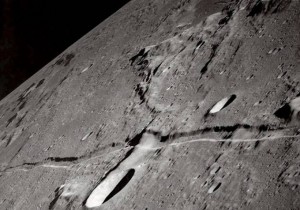Splitting of the Moon
One of the times when God performed miracles at the hand of the Prophet was when the Meccans demanded to see a miracle from Muhammad to show his truthfulness. God split the moon in two separate halves and then re-joined them. The Quran recorded the event:
“The Last Hour draws near, and the moon is split asunder!” (Quran 54:1)
Prophet Muhammad would recite these verses of the Quran in large congregations of the weekly Friday prayer and the bi-annual Eed prayers.[1] Had the event never occurred, Muslims themselves would have doubted their religion and many would have left it! The Meccans would have said, ‘Hey, your prophet is a liar, the moon never split, and we never saw it split!’ Instead, the believers grew stronger in their faith and the only explanation the Meccans could come up with was, ‘passing magic!’
“The Last Hour draws near, and the moon is split asunder! And if they see a sign (miracle), they turn away and say, ‘Passing magic!’- for they are bent on giving it the lie, being always wont to follow their own desires.” (Quran 54:1-3)
The splitting of the moon is confirmed through eye-witness testimony transmitted through an unbroken chain of reliable scholars so many that is it impossible that it could be false (hadith mutawatir).[2]
A skeptic might ask, do we have any independent historical evidence to suggest the moon was ever split? After all, people around the world should have seen this marvelous event and recorded it.
The answer to this question is twofold.
First, people around the world could not have seen it as it would have been daytime, late night, or early morning many parts of the world. The following table will give the reader some idea of corresponding world times to 9:00 pm Mecca time:
| Country | Time |
| Mecca | 9:00 pm |
| India | 11:30 pm |
| Perth | 2:00 am |
| Reykjavik | 6:00 pm |
| Washington D.C. | 2:00 pm |
| Rio de Janeiro | 3:00 pm |
| Tokyo | 3:00 am |
| Beijing | 2:00 am |
Also, it is not likely that a large number of people in lands close by would be observing the moon at the exact same time. They had no reason to. Even if some one did, it does not necessarily mean people believed him and kept a written record of it, especially when many civilizations at that time did not preserve their own history in writing.
Second, we actually have an independent, and quite amazing, historical corroboration of the event from an Indian king of that time.
Kerala is a state of India. The state stretches for 360 miles (580 kilometers) along the Malabar Coast on the southwestern side of the Indian peninsula.[3] King Chakrawati Farmas of Malabar was a Chera king, Cheraman perumal of Kodungallure. He is recorded to have seen the moon split. The incident is documented in a manuscript kept at the India Office Library, London, reference number: Arabic, 2807, 152-173.[4] A group of Muslim merchant’s passing by Malabar on their way to China spoke to the king about how God had supported the Arabian prophet with the miracle of splitting of the moon. The shocked king said he had seen it with his own eyes as well, deputized his son, and left for Arabia to meet the Prophet in person. The Malabari king met the Prophet, bore the two testimonies of faith, learned the basics of faith, but passed away on his way back and was buried in the port city of Zafar, Yemen.[5]
It is said that the contingent was led by a Muslim, Malik bin Dinar, and continued to Kodungallure, the Chera capital, and built the first, and India’s oldest, mosque in the area in 629 CE which exists today.
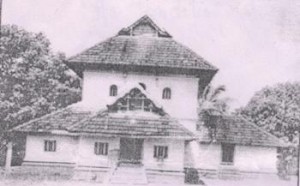
A pre-renovation picture of the Cheraman Juma Masjid, India’s oldest mosque dating back to 629 CE. Image courtesy of www.islamicvoice.com.
The news of his accepting Islam reached Kerala where people accepted Islam. The people of Lakshadweep and the Moplas (Mapillais) from the Calicut province of Kerala are converts from those days.
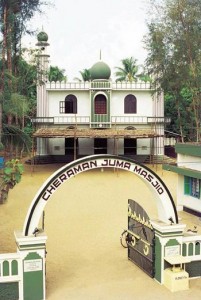
Cheraman Juma Masjid, named after India’s first Muslim convert, Cheraman perumal Chakrawati Farmas, after renovation. Image courtesy of www.indianholiday.com.
The Indian sighting and the meeting of the Indian king with Prophet Muhammad is also reported by Muslim sources. The famous Muslim historian, Ibn Kahtir, mentions the splitting of the moon was reported in parts of India.[6] Also, the books of hadith have documented the arrival of the Indian king and his meeting the Prophet. Abu Sa’id al-Khudri, a companion of Prophet Muhammad, states:
“The Indian king gifted the Prophet with a jar of ginger. The companions ate it piece by piece. I took a bite as well.”[7]
The king was thus considered a ‘companion’ – a term used for a person who met the Prophet and died as a Muslim – his name registered in the mega-compendiums chronicling the Prophet’s companions.[8]
Night Journey and Ascent to Heaven
A few months before the migration from Mecca to Medina, God took Muhammad in one night from the Grand Mosque in Mecca to al-Aqsa Mosque in Jerusalem, a month’s journey of 1230 Km for a caravan. From Jerusalem, he ascended to the heavens, passing the boundaries of the physical universe to be in divine presence, meet God, and witness the Great Signs (al-Ayat ul-Kubra). His truth became apparent in two ways. First, ‘the Prophet described the caravans he had overtaken on the way home and said where they were and about when they might be expected to arrive in Mecca; and each arrived as predicted, and the details were as he had described.’[9] Second, he was never known to have been to Jerusalem, yet he described al-Aqsa Mosque to skeptics like an eye-witness.
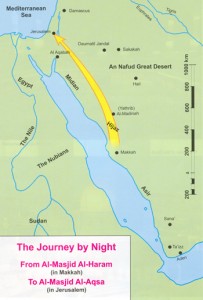
The mystical journey is mentioned in the Quran:
“Exalted is He who took His Servant [Prophet Muhammad] by night from al-Masjid al-Haram to al-Masjid al-Aqsa, whose surroundings We have blessed, to show him of Our signs. Indeed, He is the Hearing, the Seeing.” (Quran 17:1)
“So will you dispute with him over what he saw? And he certainly saw him in another descent at the Lote Tree of the Utmost Boundary – near it is the Garden of Refuge (Paradise) – when there covered the Lote Tree that which covered (it). The sight (of the Prophet) did not swerve, nor did it transgress (its limit). He certainly saw of the greatest signs of his Lord.” (Quran 53:12-18)
The event is also confirmed through eye-witness testimony transmitted through the ages with an unbroken chain of reliable scholars (hadith mutawatir).[10]
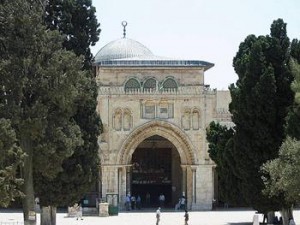
Entrance of Al-Aqsa Mosque from where Muhammad ascended the heavens. Picture courtesy of Thekra A. Sabri.
Footnotes:
[1] Saheeh Muslim.
[2] See ‘Nadhm al-Mutanathira min al-Hadith al-Mutawatir,’ by al-Kattani p. 215.
[3] “Kerala.” Encyclopædia Britannica from Encyclopædia Britannica Premium Service. (http://www.britannica.com/eb/article-9111226)
[4] It is quoted in the book “Muhammad Rasulullah,” by Muhammad Hamidullah: “There is a very old tradition in Malabar, South-West Coast of India, that Chakrawati Farmas, one of their kings, had observed the splitting of the moon, the celebrated miracle of the Holy Prophet at Mecca, and learning on inquiry that there was a prediction of the coming of a Messenger of God from Arabia, he appointed his son as regent and set out to meet him. He embraced Islam at the hand of the Prophet, and when returning home, at the direction of the Prophet, died at the port of Zafar, Yemen, where the tomb of the “Indian king” was piously visited for many centuries.”
[5] ‘Zafar: biblical Sephar , classical Sapphar, or Saphar ancient Arabian site located southwest of Yarim in southern Yemen. It was the capital of the Himyarites, a tribe that ruled much of southern Arabia from about 115 BC to about AD 525. Up until the Persian conquest (c. AD 575), Zafar was one of the most important and celebrated towns in southern Arabia—a fact attested to not only by Arab geographers and historians but also by Greek and Roman authors. After the extinction of the Himyar kingdom and the rise of Islam, Zafar gradually fell into decay.’ “Zafar.” Encyclopædia Britannica from Encyclopædia Britannica Premium Service. (http://www.britannica.com/eb/article-9078191)
[6] ‘Al-Bidaya wal-Nihaya,’ by Ibn Kathir, vol 3, p. 130.
[7] Reported by Hakim in ‘Mustadrik’ vol 4, p. 150. Hakim comments, ‘I have not memorized any other report stating the Prophet ate ginger.’
[8] ‘Al-Isaba’ by Ibn Hajr, vol 3. p. 279 and ‘Lisan ul-Mizan’ by Imam al-Dhahabi, vol. 3 p. 10 under the name ‘Sarbanak,’ the name with which the Arabs knew him.
[9] ‘Muhammad: His Life Based on the Earliest Sources’ by Martin Lings, p. 103.
[10] Forty five companions of the Prophet transmitted the reports on his Night Journey and the Heavenly Ascent. See the works of hadith masters: ‘Azhar al-Mutanathira fi al-Ahadith al-Mutawatira’ by al-Suyuti p. 263 and ‘Nadhm al-Mutanathira min al-Hadith al-Mutawatir,’ by al-Kattani p. 207.
__________________________________
Source: www.islamreligion.com
 Arabic
Arabic English
English Spanish
Spanish Russian
Russian Romanian
Romanian korean
korean Japanese
Japanese
